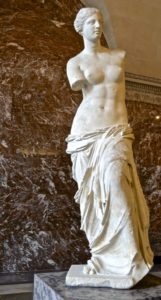The theft of the Goddess of Love
The Archaeological Museum has been compromised, as hackers have managed to disable the central alarm system and illegally enter the museum at night time. They have stolen the statue of the Goddess of Love and left a mysterious note in its place. The thief has left a trail of clues and puzzles as a sign of revenge, with the sole purpose to reveal his/her identity only to those who are educated about art and are worthy in that manner. Players need to follow the clues that lead to the identity of the thief and the location of the stolen statue. The clues are based on important artwork, artistic methods, and the theory of art, especially having to do with the specific Goddess and her importance as an international cultural heritage figure.
Aphrodite / Venus
Aphrodite / Venus is a Greco-Roman, mythical Goddess who is known as the Goddess of Love and Fertility. She is the source of inspiration for various cultural heritage events as well as artwork.
Aphrodite / Venus is known as the Goddess of Love and Fertility. She is associated with gardens and cultivated fields. She was worshipped for protecting all products of the land, vegetation as well as copper. Due to her association with Cyprus as her perceived birthplace, Cypriot hold multiple cultural heritage events in her name and many heritage sites are devoted to her. Aphrodite is the source of inspiration for countless Art pieces/work, such as statues, heritage sites, sculptures, domestic murals, fresco, mosaics, shrines, theaters and more. Her beauty inspired millions of artwork that currently constitute important artistic pieces globally. The myth about her birth from the sea’s foam inspired the great painting of Venus by Sandro Botticelli in 1486. Ancient items discovered in Cyprus and other European cities depict her, all used with materials of the time and are now considered important cultural artefacts.

